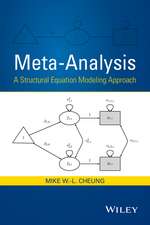Applied Probability: Mathematical Concepts and Methods in Science and Engineering, cartea 23
Autor Frank A. Haighten Limba Engleză Paperback – 26 noi 2012
Din seria Mathematical Concepts and Methods in Science and Engineering
-
 Preț: 402.38 lei
Preț: 402.38 lei - 18%
 Preț: 782.07 lei
Preț: 782.07 lei -
 Preț: 395.47 lei
Preț: 395.47 lei -
 Preț: 386.39 lei
Preț: 386.39 lei -
 Preț: 397.59 lei
Preț: 397.59 lei -
 Preț: 400.10 lei
Preț: 400.10 lei -
 Preț: 384.31 lei
Preț: 384.31 lei -
 Preț: 384.48 lei
Preț: 384.48 lei -
 Preț: 390.08 lei
Preț: 390.08 lei -
 Preț: 382.75 lei
Preț: 382.75 lei -
 Preț: 386.39 lei
Preț: 386.39 lei - 20%
 Preț: 642.52 lei
Preț: 642.52 lei -
 Preț: 398.15 lei
Preț: 398.15 lei -
 Preț: 388.90 lei
Preț: 388.90 lei - 15%
 Preț: 653.79 lei
Preț: 653.79 lei - 20%
 Preț: 333.72 lei
Preț: 333.72 lei - 15%
 Preț: 639.25 lei
Preț: 639.25 lei - 20%
 Preț: 336.86 lei
Preț: 336.86 lei -
 Preț: 382.75 lei
Preț: 382.75 lei - 15%
 Preț: 653.00 lei
Preț: 653.00 lei - 15%
 Preț: 604.70 lei
Preț: 604.70 lei -
 Preț: 391.02 lei
Preț: 391.02 lei - 18%
 Preț: 946.72 lei
Preț: 946.72 lei - 18%
 Preț: 956.69 lei
Preț: 956.69 lei -
 Preț: 388.90 lei
Preț: 388.90 lei - 18%
 Preț: 956.18 lei
Preț: 956.18 lei - 15%
 Preț: 644.63 lei
Preț: 644.63 lei - 18%
 Preț: 957.32 lei
Preț: 957.32 lei - 18%
 Preț: 1233.37 lei
Preț: 1233.37 lei - 18%
 Preț: 1233.52 lei
Preț: 1233.52 lei -
 Preț: 392.37 lei
Preț: 392.37 lei - 18%
 Preț: 957.94 lei
Preț: 957.94 lei - 15%
 Preț: 638.89 lei
Preț: 638.89 lei - 18%
 Preț: 950.03 lei
Preț: 950.03 lei - 15%
 Preț: 648.74 lei
Preț: 648.74 lei
Preț: 387.96 lei
Nou
Puncte Express: 582
Preț estimativ în valută:
74.23€ • 77.72$ • 61.43£
74.23€ • 77.72$ • 61.43£
Carte tipărită la comandă
Livrare economică 05-19 aprilie
Preluare comenzi: 021 569.72.76
Specificații
ISBN-13: 9781461564690
ISBN-10: 1461564697
Pagini: 304
Ilustrații: XI, 290 p.
Dimensiuni: 152 x 229 x 16 mm
Greutate: 0.41 kg
Ediția:Softcover reprint of the original 1st ed. 1981
Editura: Springer Us
Colecția Springer
Seria Mathematical Concepts and Methods in Science and Engineering
Locul publicării:New York, NY, United States
ISBN-10: 1461564697
Pagini: 304
Ilustrații: XI, 290 p.
Dimensiuni: 152 x 229 x 16 mm
Greutate: 0.41 kg
Ediția:Softcover reprint of the original 1st ed. 1981
Editura: Springer Us
Colecția Springer
Seria Mathematical Concepts and Methods in Science and Engineering
Locul publicării:New York, NY, United States
Public țintă
ResearchCuprins
1. Discrete Probability.- 1.1. Applied Probability.- 1.2. Sample Spaces.- 1.3. Probability Distributions and Parameters.- 1.4. The Connection between Distributions and Sample Points: Random Variables.- 1.5. Events and Indicators.- 1.6. Mean and Variance.- 1.7. Calculation of the Mean and Variance.- 1.8. The Distribution Function.- 1.9. The Gamma Function and the Beta Function.- 1.10. The Negative Binomial Distribution.- 1.11. The Probability Generating Function.- 1.12. The Catalan Distribution.- 1.13. More about the p.g.f.; The Equation s = ?(s).- 1.14. Problems.- 2. Conditional Probability.- 2.1. Introduction. An Example.- 2.2. Conditional Probability and Bayes’ Theorem.- 2.3. Conditioning.- 2.4. Independence and Bernoulli Trials.- 2.5. Moments, Distribution Functions, and Generating Functions.- 2.6. Convolutions and Sums of Random Variables.- 2.7. Computing Convolutions: Examples.- 2.8. Diagonal Distributions.- 2.9. Problems.- 3. Markov Chains.- 3.1. Introduction: Random Walk.- 3.2.Definitions.- 3.3. Matrix and Vector.- 3.4. The Transition Matrix and Initial Vector.- 3.5. The Higher-Order Transition Matrix: Regularity.- 3.6. Reducible Chains.- 3.7. Periodic Chains.- 3.8. Classification of States. Ergodic Chains.- 3.9. Finding Equilibrium Distributions—The Random Walk Revisited.- 3.10. A Queueing Model.- 3.11. The Ehrenfest Chain.- 3.12. Branching Chains.- 3.13. Probability of Extinction.- 3.14. The Gambler’s Ruin.- 3.15. Probability of Ruin as Probability of Extinction.- 3.16. First-Passage Times.- 3.17. Problems.- 4. Continuous Probability Distributions.- 4.1. Examples.- 4.2. Probability Density Functions.- 4.3. Change of Variables.- 4.4. Convolutions of Density Functions.- 4.5. The Incomplete Gamma Function.- 4.6. The Beta Distribution and the Incomplete Beta Function.- 4.7. Parameter Mixing.- 4.8. Distribution Functions.- 4.9. Stieltjes Integration.- 4.10. The Laplace Transform.- 4.11. Properties of the Laplace Transform.- 4.12. Laplace Inversion.- 4.13. Random Sums.- 4.14. Problems.- 5. Continuous Time Processes.- 5.1. Introduction and Notation.- 5.2. Renewal Processes.- 5.3. The Poisson Process.- 5.4. Two-State Processes.- 5.5. Markov Processes.- 5.6. Equilibrium.- 5.7. The Method of Marks.- 5.8. The Markov Infinitesimal Matrix.- 5.9. The Renewal Function.- 5.10. The Gap Surrounding an Arbitrary Point.- 5.11. Counting Distributions.- 5.12. The Erlang Process.- 5.13. Displaced Gaps.- 5.14. Divergent Birth Processes.- 5.15. Problems.- 6. The Theory of Queues.- 6.1. Introduction and Classification.- 6.2. The M? / M? / 1 Queue: General Solution.- 6.3. The M? / M? / 1 Queue: Oversaturation.- 6.4. The M? / M? / 1 Queue: Equilibrium.- 6.5. The M? / M? / n Queue in Equilibrium: Loss Formula.- 6.6. The M? / G? / 1 Queue and the Imbedded Markov Chain.- 6.7. The Pollaczek-Khintchine Formula.- 6.8. Waiting Time.- 6.9. Virtual Queueing Time.- 6.10. The Equation y = xe?x.- 6.11. Busy Period: Borel’s Method.- 6.12. The Busy Period Treated as a BranchingProcess: The M / G /1 Queue.- 6.13. The Continuous Busy Period and the M / G /1 Queue.- 6.14. Generalized Busy Periods.- 6.15. The G / M /1 Queue.- 616 Balking.- 6.17. Priority Service.- 6.18. Reverse-Order Service (LIFO).- 6.19. Problems.














